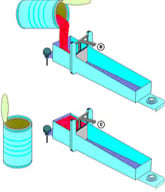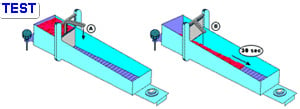The Bostwick Consistometer is used all over the World to check the quality of sauces and condiments. In our in-house training session we do blind product tests and clearly define the differences between brand of ketchup and mustard. This is a testament to the value placed on Bostwick Consistometer tests by the top food manufacturers.
We continually get questions about set-up of the consistometer. It is very simple to operate. Consequently, questions about set-up and theory of operation are often given short shrift.
But first I’ll go through the operation and conduct of a test. The simplicity of operation is shown in these illustrations.
The Consistometer is built around a trough approximately 14 inches long. There are marks one-half centimeter apart along the bottom of the trough. These marks are sometimes referred to as Bostwicks. About two inches from one end is a spring loaded gate. The gate can be closed and a notched lever holds it in that position until released by pushing down on the lever arm.
The closed gate forms a small reservoir behind it.
 To run a test, first you close and lock the gate with the lever arm in the up position.
To run a test, first you close and lock the gate with the lever arm in the up position.
Now it’s time to pour in the sample. Fill the reservoir up to the top of the gate.
The next step is to release the product by pressing down on the lever arm . Allow the product to run through the trough for 30 sec.
Observe how far the product traveled down the trough in the 30 sec.


The trough has gradation marks indicating the distance in centimeters. Record this value as the consistency of the product.
Now that you see how simple the test procedure is, I’ll give a little theory about what the test really measures. Consistency is a measurement of how a material flows against itself because the force of gravity. Sort of like sagging. Therefore, when the gate is released the sample begins to sag and drifts down the trough. The distance it travels in fixed length of time is know as its consistency.
In our training case, in 30 seconds a thicker mustard will travel less distance than a thinner mustard. Thus the thicker mustard will have a lower Bostwick reading.
Now For A Source Of Confusion
The set-up procedures call for the Bostwick Consistometer to be leveled using the bubble level attached to the instrument. If it appears that the small front foot is bent the procedure is to place a small level in the trough and level that. Despite these instructions supplier companies and their customers often get in serious discussions about the angle that trough should set.
This confusion can be eliminated when you refer back to the discussion of what consistency is: Consistency is a measurement of how a material flows against itself because the force of gravity. Sort of like sagging. Thus to have it sag properly the trough must be level and not at an angle.
Even if you never have the occasion to measure consistency or Bostwicks, I hope you found this exchange interesting. You may never look at the supermarket sauce and condiments shelves the same again.
Please share this with associates who deal with quality control in liquid processes.
Until next time,
Warmest regards,
Art
P.S. Be the first to know when we post a new blog article. Subscribe at the top of the page today!
P.P.S. See how to run a Bostwick Consistometer Test (A Video)


